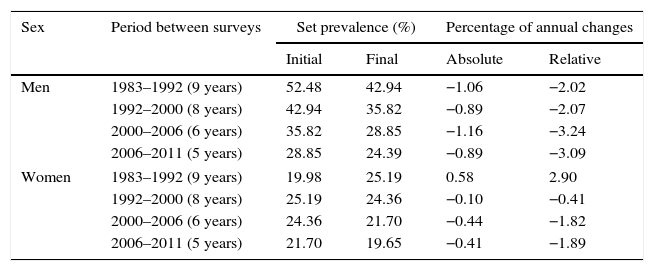The objective of this study is to describe the distribution of smoking in the population and to assess changes and trends over recent decades.
Materials and methodsCross sectional study in a sample of the non-institutionalized resident population (n=3,509) in Barcelona (Catalonia, Spain) using data from persons over 14 years of age from the health survey of 2011, and assessing trends for 1983–2011 using previous surveys. Dependent variables are having ever been a smoker, having quit, being a current smoker, and smoking daily. Independent variables include sex, age, and time. Prevalence and proportions are estimated, stratifying or adjusting for age.
ResultsThe prevalence of daily smokers is 18.8% in 2011: 22.2% for men and 15.9% for women. The age groups with higher smoking prevalence are 25–34 years for men and 15–24 for women. From 1983 to 2011 the reduction among men has been intense, and for women the prevalence has been decreasing since the survey of 2000. Among smokers, the proportion of both genders who do not smoke daily has increased.
ConclusionsThe smoking epidemic over the last years shows promising trends. The data do not lend support to the hardening hypothesis for current smokers. Smokers are a shrinking minority, although to improve public health it would be desirable to speed the process of change.
El objetivo de este trabajo es presentar la distribución del tabaquismo en la población y valorar los cambios y tendencias en las últimas décadas.
Material y métodoEstudio transversal en una muestra de población residente no institucionalizada (n=3.509) en Barcelona (Cataluña, España), a partir de los datos de los mayores de 14 años de la encuesta de salud de 2011, analizando tendencias entre 1983 y 2011 mediante encuestas anteriores. Las variables dependientes son haber sido alguna vez fumador/a, haber dejado de fumar, fumar actualmente y fumar diariamente. Las variables explicativas son el sexo, la edad y el período. Se estiman prevalencias y proporciones, estratificando o ajustando por edad.
ResultadosLa prevalencia de personas fumadoras diarias es de un 18,8% en 2011: un 22,2% en hombres y un 15,9% en mujeres. Los grupos de edad más fumadores son el de 25-34 años en hombres y el de 15-24 años en mujeres. Entre 1983 y 2011 la disminución de la prevalencia en hombres ha sido intensa y en mujeres se aprecia el descenso desde 2000. En ambos sexos la proporción de personas fumadoras que no fuman diariamente es cada vez mayor.
ConclusionesLa evolución de la epidemia tabáquica en los últimos años muestra tendencias esperanzadoras. Los datos no apoyan la hipótesis de que las personas fumadoras actualmente sean más adictas. Fumar es cada vez más minoritario, aunque para mejorar la salud pública sería deseable que el descenso fuera más rápido.
Artículo
Comprando el artículo el PDF del mismo podrá ser descargado
Precio 19,34 €
Comprar ahora








